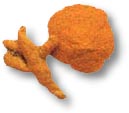|
 
|
The web site........,
exploring
the pure
Indian spices
and....
imperishable
dry vegetables
of
THAR....the great desert
.
|
| |
| |
|
Turmeric has a
mild, earthy and woody flavour. It stimulates protein digestion, and
is an excellent blood purifier. The use of turmeric as a colouring
agent in food and dates back as far as 600 B.C. In medieval Europe,
turmeric was known as Indian Saffron. |

|
|
India is the world’s leading producer of turmeric. The well-known
varieties are `Allepy finger’ (from Kerala), `Madras Finger’ and
`Erode turmeric’ (from Tamil Nadu).
|
Name in International
languages
| Spanish |
Curcuma |
| French |
Curcuma |
| German |
Kurkuma
Gelbwurzel |
| Swedish |
Gurkmeja |
| Arabic |
Kurkum |
| Dutch |
Geelwortel |
| Italian |
Curcuma |
| Portuguese |
Acafrao-da-India
|
| Russian |
Zholty Imbir |
| Japanese |
Ukon |
| Chinese |
Yu.Chin |
| Hindi |
Haldi |
|
Botanical name |
Family name |
Commercial part |
|
Curcuma longa L. |
Zingiberaceae |
Rhizome or underground stem |
|
Cultural
name |
English
name |
Botanical
name |
Moisture
g/100g |
Protein
g/100g |
Fat
g/100g |
Minerals |
Fiber
(g) |
Carbohydr
ate
g/100g |
Energy
Keal/1000g |
|
Haldi |
Turmeric
|
Curuima domestica |
13.1 |
6.3 |
5.1 |
3.5 |
2.6 |
69.4 |
249 |
| |
|
|
Calcium
mg/100g |
Iron
mg/100g |
Phosphorus
mg/100g |
| |
|
|
150 |
67.8 |
282 |

The Hindus in India use turmeric to
marinate fish before cooking. Turmeric is both used as a colouring and
flavouring agent in Indian cuisine. Solutions of turmeric have long been
used in the treatment of wounds, eye infections and common cold.
|
|